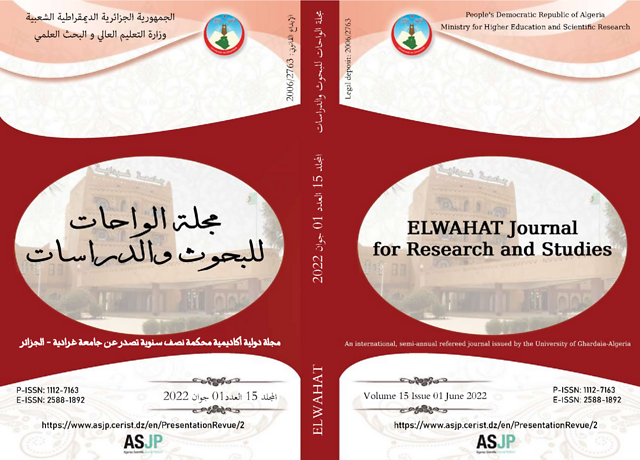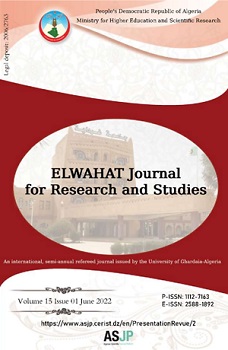Factorial Structure of the Teacher's Quality of Work Life Scale
Abstract
ABSTRACT:
The present research paper attempts to develop a valid and reliable measurement instrument that is designed to measure Quality Work Life (QWL) of elementary Algerian school teachers. This research relies on a questionnaire that includes 30 questions distributed to a sample that consists of 239 teachers. An exploratory factor analysis is applied to determine the number of factors of QWL. A confirmatory factor analysis is relied upon to verify the number of factors. To verify the validity and reliability of the device, a structural validity and a composite reliability are determined. The six significant factors are identified based on the factor analysis. Further analyses have revealed that these six factors together proved 64.55 % of the total variance.
Keywords: measurement instrument; Quality of Work Life; factorial structure.
ملخص:
يهدف هذا البحث إلى تطوير أداة قياس صالحة وموثوقة مصممة لقياس جودة حياة العمل (QWL) لمعلمي المدارس الابتدائية الجزائرية. تكون المقياس من 30 فقرة تم تطبيقها على 239 معلمًا ومعلمة. تم إجراء تحليل العاملي استكشافي لتحديد عدد عوامل جودة حياة العمل. ثم إجراء تحليل العاملي التأكيدي للتحقق من عدد العوامل، للتحقق من صحة وموثوقية المقياس، تم تحديد الصلاحية الهيكلية والموثوقية المركبة، كما تم تحديد العوامل الستة الهامة بناءً على تحليل العوامل. أظهر التحليل الإضافي أن هذه العوامل الستة مجتمعة أوضحت 64.55٪ من التباين الكلي.
كلمات دالة: أداة قياس؛ جودة حياة العمل؛ هيكل عاملي.References
- Boisvert, M. P. (1977). The quality of working life. An analysis. Human Relations. 30(2): 155-160.
- Carlson, H.C. (1978). On QWL in General Motors. The Indian Journal of Social Work, 12(03): 198-210.
- Davis, L.E. & Cherns A.B.(1975). The quality of working life. I & II, New York.
- Fen, Y. S. & Sabaruddin, N. A.(2008). An Extended Model of Theory of Planned Behaviour in Predicting Exercise Intention. Int. Bus. Res., 1(4): 108-122.
- Fornell, C. & Larcker, D. F.(1981). Evaluating Structural Equations with Unobservable Variables and Measurement Error. Journal of Marketing Research, (18): 39-50.
- Hair, J.F., Black, W.C., Babin, B.J. & Anderson, R.E.(2010). Multivariate Data Analysis, (7th ed). Upper Saddle River, NJ: Prentice Hall.
- Hair, J.F., Black, W.C., Babin, B.J., Anderson, R.E. & Tatham, R.L. (2006). Multivariate Data Analysis(6th ed). Upper Saddle River, NJ: Prentice-Hall.
- Nadler, D. A., & Lawler, E. E. (1983). Quality of work life: Perspectives and directions. Organizational Dynamics, 11(3): 20-30.
- Nunnally, J. C.(1978). Psychometric theory (2nd ed.). New York: McGraw-Hill.
- Sinha, P. & Sayeed, O.B.(1980). Measuring quality of work life development of an inventory, Journal of Social Work, 41(3): 220-246.
- Sirgy, J.M., Efraty, D, Siegel, P., & Lee, D. (2001). A new Measure of Quality of Work Life (QWL) Based on Need Satisfaction and Spillover Theories. Social Indicators Research, 55(3): 241-302.
- Spink, P.(1975). Some comments on quality of work life. Journal of occupational psychology, September, 48(3): 179-148.
- Straub, D., Boudreau, M. C. & Gefen, D. (2004). Validation Guidelines for IS Positivist Research. Communications of the AIS 13(24): 380-427.
- Taylor, J.C.; Landy, J.; Levine, M. & Kamath, D.R.(1973).The Quality of Working Life: An Annotated Bibliography 1957-72, a research report to The Manpower Administration, U.S. Department of Labor (Los Angeles: Center for Organizational Studies, Graduate School of Management, University of California.
- Walton, R. (1975).Criteria for quality of work life. In L.E. Davis & R.L. Cherns (Ed.), The Quality of Working Life: Problems, Prospects, and the State of the Art. New York: Free Press. (1):12-54.
- Walton, R.E. (1980). Quality of work life activities: A research agenda. Professional Psychology, 11(3): 484-497.
- Gaskin, J. (2012). Stats Wiki and Stats Tools Package.
http://statwiki.kolobkreations.com(consulted on jun 12, 2018).







